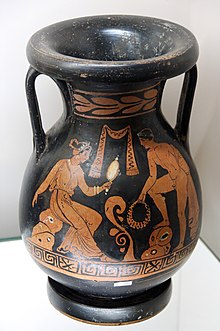Pelike

A pelike (Ancient Greek: πελίκη) is a one-piece ceramic container similar to an amphora.
It has two open handles that are vertical on their lateral aspects and even at the side with the edge of the belly, a narrow neck, a flanged mouth, and a sagging, almost spherical belly.
Unlike the often-pointed bottom of many amphorae, the pelike's bottom is always flanged so it will stand on its own.
Pelikes are often intricately painted, usually depicting a scene involving people. The shape first appeared at the end of the 6th century BCE and continued to the 4th century BCE.
External links
Wikimedia Commons has media related to Pelikai.
- Red-Figure Pelike by the Darius Painter
- Neck-pelike with aulodic contest
- British Museum: Red-figure pelike, attributed to the Marsyas Painter
- Shapes of Greek pottery
